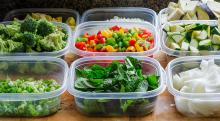
Everybody likes getting more for less! How about getting more meals from less daily meal prep? With some meal planning and prepping, you can make several days’ worth of meals with one trip to the grocery store.
Diabetes Food Hub can be a great tool for meal prepping! Learn how to use our recipes, meal planner, and grocery list generator to make planning, shopping, and prepping healthy meals easy—and check out this article for tips on building the perfect salad!
How to prep your salad bar

1. Wash your greens. For heads of lettuce like iceberg or romaine, remove damaged or wilted outer leaves, cut out the core, and chop the rest. Rinse chopped lettuce and loose greens in a colander or bowl of water. Drain and dry the greens as well as you can before storing them by using a salad spinner or patting them dry with paper towels. Store greens in a large container or bag. To keep them crisp, add a damp paper towel to the container and re-wet as needed during the week.
2. Wash fresh fruits and other vegetables. Thoroughly wash produce under cool running water and remove any damaged areas. Dry veggies and fruits with a paper towel to help prevent bacterial growth. Next, prep veggies and fruit for your salad by chopping them into bite size pieces.
3. Prep your proteins. Choose lean proteins like chicken, fish, eggs, or plant-based proteins like tofu or tempeh. Bake or grill the lean protein of choice, then cut into slices or cubes. If you are using fish, you can either use canned fish or bake your fillets (they can be fresh or frozen). Leave the fillets whole or break apart with a fork and store. For hard boiled eggs, it’s best to leave them whole (with or without their shell) and slice or chop just before adding it to the salad. Low-fat cheese is also a protein that can be added to salads either by using shredded cheese or cutting cheese blocks into small cubes.
4. Cook your grains. If you like quinoa, wild rice, brown rice, or other grains in your salad, cook it ahead of time! You can store it in a container in the fridge and add the cold cooked grain to your salad as your source of quality carbohydrate. Or heat up the cooked grain in the microwave to add a little warmth to a cold salad.
5. Prep your add ins. Fresh herbs or nuts can be lower carb add ins for your salad. Wash and chop the herbs, chop the nuts if you’d like, and place them in a small storage container so they are ready to be added to your salad.
6. Portion your dressing. Try a couple different types to shake things up! Portion out the dressing into small containers you can toss into your salad right before you eat it. Remember, dressings are made of mostly fat, so they can add a lot of calories to a salad.
7. Store all your salad components in separate resealable containers or bags. Some things like nuts and dried fruit do not need to be stored in the fridge.
8. Build your salad. You can prep your lunch salad the night before or in the morning. For a meal-sized salad, start with one to two handfuls of leafy greens. Add 1/2–1 cup of chopped veggies, about 3 ounces of protein (roughly the size of the palm), about 1/4–1/2 cup of whole grains, and finish with fresh herbs or nuts, if you like. You can pack everything in a large bowl with the dressing on the side or build a mason jar salad!
For a mason jar salad, build everything in reverse: start with dressing on the bottom, then add your various toppings, and finish it off with greens. When you are ready to eat, dump the jar out into a bowl. The greens will be on the bottom and the dressing will be on top!
Need more inspiration to get started?
Try these chef-inspired salad recipes, curated by the American Diabetes Association’s Nutrition and Wellness team!
- Creamy Chicken & Broccoli Basil Pesto Salad
- Seared Tempeh Salad
- Brussels sprout salad with avocado, artichokes and creamy honey mustard dressing
- Green Goddess Salad with Smoked Salmon
- Broccoli and Mandarin Orange Salad
- Watermelon and Tomato Salad














